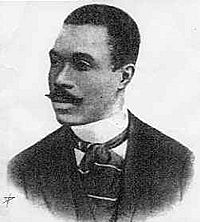João da Cruz e Sousa facts for kids
Quick facts for kids
João da Cruz e Sousa
|
|
|---|---|
 |
|
| Born | November 24, 1861 |
| Died | March 19, 1898 (aged 36) Antônio Carlos, Minas Gerais, Brazil
|
| Nationality | Brazilian |
| Occupation | Poet, journalist |
|
Notable work
|
Broquéis, Faróis, Missal |
| Spouse(s) | Gavita Gonçalves |
| Parent(s) | Guilherme da Cruz Carolina Eva da Conceição |
João da Cruz e Sousa (born November 24, 1861 – died March 19, 1898) was a famous Brazilian poet and journalist. People often called him Cruz e Sousa. He was one of the first poets in Brazil to use a style called Symbolism. Because he was a descendant of African slaves, he was sometimes called the "Black Dante" or the "Black Swan." He is honored as the patron of the 15th chair of the Academia Catarinense de Letras, which is a literary academy.
About His Life
Cruz e Sousa was born on November 24, 1861. His birth name was João da Cruz. He was born in Florianópolis, a city in the state of Santa Catarina, Brazil. At that time, the city was called Nossa Senhora do Desterro.
His parents, Guilherme da Cruz and Carolina Eva da Conceição, were both Afro-Brazilians who had been freed from slavery. João da Cruz's former owner, Marshal Guilherme Xavier de Sousa, treated him very kindly. He taught João how to read, write, and speak Greek, French, and Latin. Marshal Sousa also gave João his last name, Sousa. Cruz e Sousa also learned about Mathematics and natural sciences from a famous German biologist named Fritz Müller.
His Career and Family Life
In 1881, Cruz e Sousa became the director of a newspaper called Tribuna Popular. In this newspaper, he wrote articles that supported ending slavery. In 1883, he tried to become a lawyer for the city of Laguna. However, he was not accepted for the job because he was Black.
In 1885, he published his first book of poems, Tropos e Fantasias. He wrote this book with his friend Virgílio Várzea. In 1890, he moved to Rio de Janeiro. There, he worked as an archivist at the Estrada de Ferro Central do Brasil, which was a railway company.
In 1893, Cruz e Sousa published two very important books: Missal and Broquéis. These books were special because they brought the Symbolist movement to Brazil. In November of the same year, he married Gavita Gonçalves. She was an educated Black woman who worked as a seamstress. They had four children together. Sadly, all four of their children died very young from tuberculosis. This was a very difficult time for Gavita, and she became very ill.
Cruz e Sousa himself died from tuberculosis on March 19, 1898. He passed away in what is now the city of Antônio Carlos, in the Brazilian state of Minas Gerais.
His Books
Here are some of the books Cruz e Sousa wrote:
- Tropos e Fantasias (1885 — written with Virgílio Várzea)
- Broquéis (1893)
- Missal (1893)
- Evocações (1898)
- Faróis (1900 — published after his death)
- Últimos Sonetos (1905 — published after his death)
- O Livro Derradeiro (1945, expanded 1961 — published after his death)
- Dispersos (1961 — published after his death)
See also
 In Spanish: João da Cruz e Sousa para niños
In Spanish: João da Cruz e Sousa para niños

